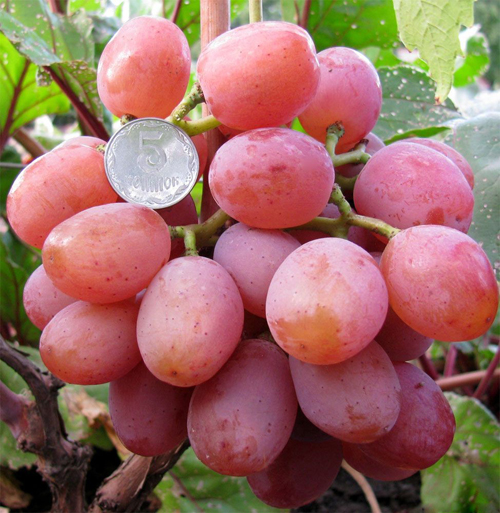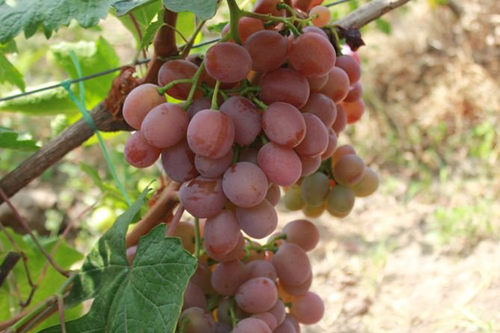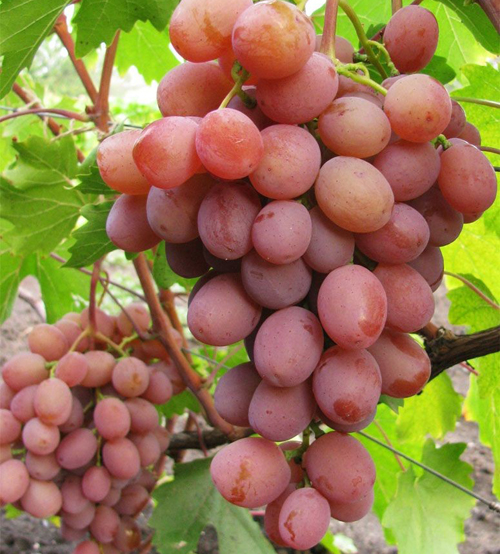Chameleon grape variety
The grape with the intriguing name Chameleon was born thanks to the works of the national breeder from Ukraine N.P. Vishnevetsky. The author has been engaged in viticulture for many decades, and in recent years he has also become interested in the development of new varieties. He considers the ideal of the "sunny berry" to be highly marketable, large and attractive outwardly forms that can withstand long-distance transportation and are suitable for long-term storage.

In a relatively short period of time, Nikolai Pavlovich managed to obtain more than fifteen new hybrids that largely meet his high requirements, especially in aesthetic terms. One of them was our hero, bred as a result of complex hybridization, in which four grape varieties were used at once - Atlant Zaporozhye, Arcadia, Glasha and Radiant kishmish... The first variety, with a functionally female flowering type, served as the maternal form, and a mixture of pollen from the last three was used for fertilization. As a result of the selection of seedlings grown from hybrid seeds, a Chameleon was isolated, which showed its early maturity, large-fruited, elegant color and splendor of taste at the very first fruiting. Subsequently, high growth energy, high productivity and good plant resistance to frost and fungal diseases were added to this list of positive qualities. Of the unambiguous shortcomings of our hero today, one can only name the tendency of the bushes to overload, which, in turn, can provoke problems with pollination, the completeness of the bunches, as well as the taste of ripe berries. However, this drawback is completely eliminable, and an experienced owner will not have difficulty in rationing plants with shoots and crops.
Many amateur winegrowers and farmers liked the novelty, and today the number of fans of the variety is actively increasing both in his homeland and in our country.

Agrobiological characteristics
The vines of the vines are extremely high They quickly gain vegetative mass and by the third year they can form their main skeleton. The axis of the young shoot and the emerging leaves are shiny, greenish-bronze due to intense anthocyanin pigmentation. Full leaves are large, rounded or extended in width, usually five-lobed with an average degree of dissection. The leaf blade is glossy, reticulate-wrinkled, rich green with lighter veins, which often turn out to be reddish at the base. The upper side cutouts are open, of moderate depth, slit-like, or in the form of a retraction angle. The lower notches are noticeably smaller, from barely outlined to V-shaped. The petiolate notch is predominantly vaulted, with a flat or pointed bottom. Petioles are long, deep reddish in color. The teeth along the perimeter of the leaf are large, mostly triangular, have regular even edges and sharp tops. Chameleon flowers are bisexual, which in practice should mean the ability to fully self-pollinate. However, many growers complain about overly loose, so-called "torn" clusters, and numerous small seedless berries, as a result of which the presentation of the crop is very low. At the same time, they also often admit that they are sorry to thin out the grape inflorescences, removing the extra ones, because of their magnificent size. This is usually the root of the problem. Plants, with the help of shedding the ovaries, regulate their load themselves, if their owner did not consider it necessary to do so. As a result, the number of brushes is large, but their appearance leaves much to be desired. In the case of a normal load, such problems practically do not occur in the variety. The vine always ripens well, turning brown.

With proper care, standard bunches grow very large, weighing 1000-1500 grams, and the most outstanding "pull" and 2 kg.Their shape is conical or cylindro-conical, the structure is moderately dense. In a cluster, the grapes do not fit too tightly to each other, so they do not deform and are well ventilated. The combs of the bunches are strong and sturdy, capable of supporting the weight of even the most gigantic fruits. The berries are formed in a beautiful oval shape, with an average length of 30-32 mm, a diameter of 26-28 mm, and weighing 10-14 grams. Outside, they are painted in a light pink color, the intensity of which, as befits a Chameleon, can vary depending on the illumination of the fruit zone of the bushes during ripening. The surface of the grapes is covered with a thin layer of a light, easily washable wax coating. The pulp of grapes is juicy and fleshy, very sweet, with a neutral aroma and aftertaste. When chewed, the berry emits a pleasant crunch due to the dense, but medium-thick peel. The sugar content of freshly squeezed juice is higher than average for table varieties, and is up to 18 g / 100 ml. The titratable acidity, at the same time, does not exceed 6 g / l. Seeds are present in normally pollinated grapes, however, due to their small number and volume, they do not worsen the tasting ratings of our hero, which traditionally turn out to be very high.
This grape is cultivated in a wide variety of types of farms, and the options for its use are also very numerous. Farmers appreciate it for its excellent marketability and excellent taste, which allow the harvested bunches to be deservedly considered "market" ones, and do not stay long on the shelves. A great competitive advantage for the commercial use of the form is its characteristic very early ripening period, which allows the grapes to be sold in a period of high prices, and thereby achieving excellent profitability of its cultivation. Cut bunches tolerate transportation well, but they are not particularly prone to long-term storage. For this reason, in individual farms, where the "sun berry" is cultivated for themselves, the surplus of bountiful harvests is often processed for home preservation, which is distinguished by tender color and gastronomic splendor.
The variety really reaches the ripening maturity very early - only after 100-110 days from the start of the growing season, counted from the budding in the spring. In the southern regions of our country, the mass harvesting of grapes can be started already in early August, when the sum of active temperatures reaches 2200-2300 ° C. Such a modest need for heat supply opens up prospects for the Chameleon to move to regions unconventional for viticulture, which many amateurs from central Russia are already beginning to use. The main thing is to provide reliable protection of plants from frost damage, because the resistance of the vine to low winter temperatures does not exceed -23 ° C.
The productivity of the bushes can be very high - up to 30 kg of high-quality grapes, but this requires a high level of agricultural technology. Otherwise, congestion can lead to the troubles mentioned above. On average, the plants are loaded in the spring with no more than 30 eyes with a moderate length of fruit arrows. Then a fragment of sterile shoots is produced, and no more than one inflorescence is left on the fertile vines.
After ripening, the bunches can be safely left on the bushes due to the good resistance of this variety to cracking. And the chameleon is not affected too much by fungal diseases, and therefore it is able to grow in conditions of infrequent preventive treatments.








